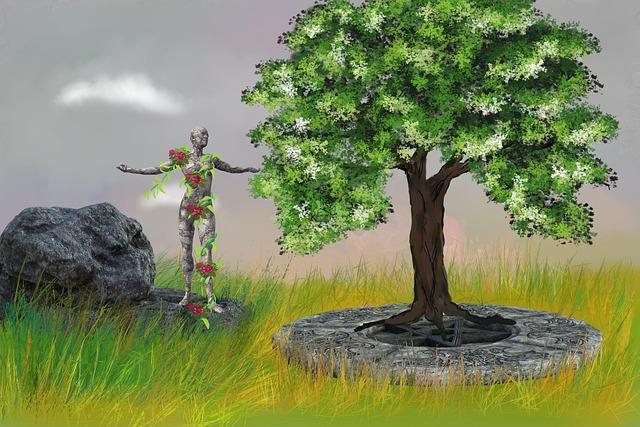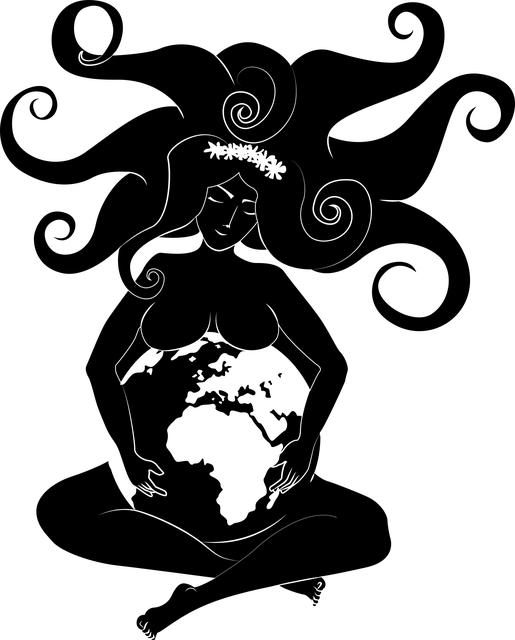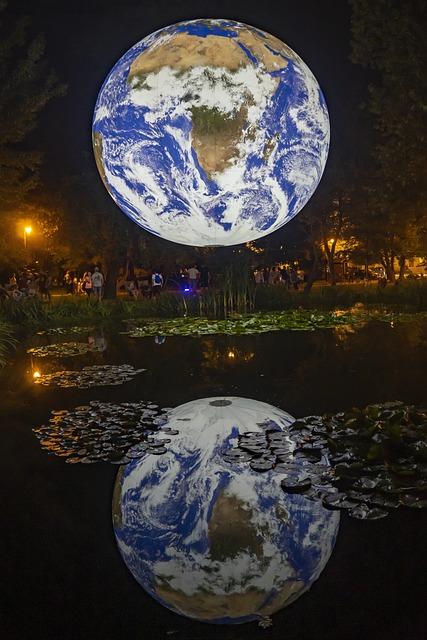Table of Contents
- Exploring the Concept of Gaia and Its Philosophical Roots
- The Connection Between Gaia and Environmental Sustainability
- Gaia Hypothesis: Understanding Earths Living Organism
- Practical Applications of Gaia Principles in Daily Life
- Reconnecting with Nature: Embracing the Gaia Perspective
- Q&A
- In Retrospect

Exploring the Concept of Gaia and Its Philosophical Roots
The Gaia hypothesis, first articulated by James Lovelock in the 1970s, suggests that Earth functions as a self-regulating, complex system, where organic and inorganic components coalesce to sustain life. This idea draws heavily from ancient philosophical beliefs that view the Earth not merely as a planet but as a living entity. The term “Gaia” itself originates from Greek mythology, where Gaia is the personification of Earth, symbolizing fertility and the nurturing aspects of nature. This ancient perspective provides a rich backdrop for understanding our relationship with the planet.
Philosophically, the roots of the Gaia concept can be traced back to several influential thinkers. The Presocratic philosophers were among the first to delve into the interconnectedness of nature, emphasizing that all elements of the universe are interrelated. Furthermore, Eastern philosophies such as Taoism and Buddhism offer insights into the harmony and balance between humanity and nature, promoting respect and symbiosis. This ideation challenges the anthropocentric narrative of dominion over the Earth, urging us to adopt a more holistic view of our ecosystem and our role within it.
As we continue to grapple with contemporary environmental challenges, the relevance of Gaia’s philosophical underpinnings becomes increasingly critical. By recognizing key aspects of this concept, we can foster a deeper understanding of sustainability and stewardship. Notably, these aspects include:
- The Interconnectedness of Life: Every action affects the larger ecological web.
- Self-Regulation: Natural systems maintain equilibrium through feedback mechanisms.
- Holistic Perspective: Emphasizing the whole rather than individual components to promote environmental well-being.
When we consider these principles, we encourage a paradigm shift towards more sustainable practices, intertwining our philosophical foundations with ecological responsibility.
The Connection Between Gaia and Environmental Sustainability
The concept of Gaia, originating from Greek mythology, embodies the idea of Earth as a living organism. This perspective profoundly influences our approach to environmental sustainability. By viewing the planet not merely as a resource but as a dynamic entity interconnected with all living things, we awaken to the responsibilities we hold in nurturing and protecting our world. This holistic view encourages a deeper awareness of the relationships between ecosystems, urging us to consider how our actions can impact the delicate balance of life.
Emphasizing the interconnectedness of all organisms encourages sustainable practices. Here are some key principles inspired by the Gaia hypothesis that underline the importance of environmental sustainability:
- Balance and Harmony: Recognizing that ecosystems thrive on balance, promoting biodiversity is essential for resilience.
- Interdependence: Understanding that all species rely on one another drives initiatives for conservation and habitat protection.
- Long-Term Health: A sustainable approach to resource management necessitates foresight, ensuring that future generations can enjoy a rich and diverse natural world.
Incorporating Gaia’s principles into our daily lives can enhance our commitment to sustainability. It encourages a shift from a consumption-driven culture to values that promote conservation and respect for the planet. Educational programs highlighting this connection can foster community engagement and inspire individual actions, creating a cultural norm centered around environmental stewardship. This shift is vital not just for the survival of our ecosystems, but also for the well-being of humanity as we collectively navigate the environmental challenges of the 21st century.

Gaia Hypothesis: Understanding Earths Living Organism
The Gaia Hypothesis, formulated by scientist James Lovelock in the 1970s, proposes that Earth functions as a self-regulating, complex system where living organisms interact with their inorganic surroundings to sustain life. This concept redefined our understanding of the planet, positing that life does not merely inhabit Earth but actively contributes to creating conditions conducive to its own existence. The crux of the hypothesis lies in the idea that organisms, from the tiniest bacteria to the largest mammals, work in concert with geological and atmospheric processes to maintain a balanced ecosystem.
At the heart of the Gaia Hypothesis is the belief that all life forms contribute to the resilience of the Earth’s environment through various feedback mechanisms. Through processes such as respiration, photosynthesis, and decomposition, living organisms play critical roles in regulating important factors like temperature, atmospheric composition, and the water cycle. For instance, the excess carbon dioxide generated from animal respiration is used by plants during photosynthesis, which in turn releases oxygen back into the atmosphere. This *interconnected web of life* fosters stability, illustrating how changes in one component can ripple throughout the entire system.
To further explore this captivating idea, consider the following aspects of the Gaia Hypothesis:
- Mutualism: Organisms engage in relationships that benefit both, promoting biodiversity.
- Homeostasis: The Earth’s biosphere maintains conditions within a range that supports life.
- Adaptation: Species evolve over time, contributing to the planet’s resilience against environmental changes.
As scientists delve deeper into understanding the intricate relationships between organisms and their environments, the implications of the Gaia Hypothesis continue to resonate. Its emphasis on interconnectedness not only enriches our appreciation of nature but also challenges us to rethink how we approach environmental issues. In a world facing climate change and ecological disturbance, this hypothesis urges us to recognize the delicate balance of life on our planet, highlighting the need for sustainable practices that honor these vital connections.

Practical Applications of Gaia Principles in Daily Life
Implementing Gaia principles in daily life can transform our interactions with the environment and with each other. One practical approach is to consciously reduce our waste. By embracing the idea that everything is interconnected, we can adopt habits like composting organic waste, using reusable bags and containers, and opting for products with minimal packaging. This not only benefits our planet but encourages a mindful attitude toward consumption.
Another application lies in fostering community engagement. Aligning with Gaia’s vision of collective health, we can participate in community gardens, local clean-up days, or conservation groups. These activities not only nurture our surroundings but also strengthen social bonds, creating a sense of solidarity and shared responsibility. Active involvement promotes ecological awareness, empowering individuals to take part in collective preservation efforts.
Viewing our health through the lens of the Gaia theory can also inspire us to prioritize holistic wellness. This includes not just physical health but also mental and emotional wellbeing. Practices like yoga, meditation, and spending time in nature can help maintain balance. Eating locally sourced, organic foods acknowledges our connection to the environment and supports sustainable agricultural practices. By taking these steps, we can contribute positively to both our individual health and the health of the planet.

Reconnecting with Nature: Embracing the Gaia Perspective
In today’s fast-paced world, many people find themselves disconnected from the natural environment that sustains us. The Gaia perspective invites a reconnection with our planet, emphasizing the interconnectedness of all living beings and the ecosystems we inhabit. This approach encourages individuals to view Earth not merely as a resource, but as a living entity, deserving of respect and care. By nurturing this connection, we pave the way for a more sustainable and fulfilling existence.
To embrace this perspective fully, consider incorporating the following practices into your daily life:
- Nature Walks: Regularly immerse yourself in nature. Walking in parks, forests, or beaches allows you to experience the beauty of the natural world and reflect on your place within it.
- Mindful Observation: Take the time to observe your surroundings. Notice the small details, from the patterns of leaves to the behavior of animals, deepening your appreciation for life’s complexity.
- Sustainable Practices: Implement eco-friendly habits in your home and community. Small changes like reducing waste, conserving water, and opting for local produce can significantly impact the health of our planet.
Furthermore, educational initiatives play a crucial role in fostering a Gaia-centered worldview. Schools and community organizations can provide workshops and seminars focused on ecological literacy, promoting an understanding of biodiversity and the essential roles various species play. As we educate ourselves and others, we cultivate a greater sense of responsibility for our environment. This collective awareness not only nurtures our own well-being but also secures a vibrant planet for generations to come.



0 Comments